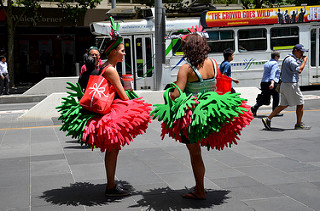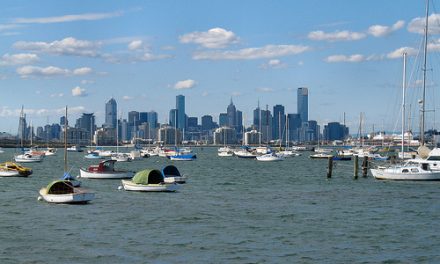I have been asked how the personal safety in Melbourne compares with that in Singapore. This is something I actually cannot easily answer.
In Melbourne, many houses do not have front fences or if they do have, the fence is so low that you can easily climb over it and hence, does not offer much of a protection in keeping off intruders. Also, most of the windows are simply glass windows, not protected by an external layer of lockable aluminium casing. I read from newspapers that a considerable number of residents do not have the habit of locking their doors when they go out for an errand. Such a practice will be unthinkable in Singapore where homes are much more heavily secured with protective locks and barriers. In government-subsidized HDB (Housing Development Board) flats, lifts are installed with CCTVs and security-coded access. I guess this elevated caution in Singapore could be due to a genuine or perceived risk of burglary or it may simply be a social or cultural phenomenon.
Singapore is said to have one of the lowest crime rates in the world, with rare incidence of violent crimes (Ref 1). In contrast, murders and serious assaults are frequently reported in Melbourne’s news media. Some of these news even grabbed international attention. The most recent case is the rape and murder of Jill Meagher which was widely circulated through social media and resulted in 30,000 people marching through the main street of Brunswick, in protest against street violence towards women (Ref 2). Not too long ago, violence against international students (in particular Indian students) had led to a drastic drop in Indian students coming to Australia for study. Of course, relying on news coverage as a measure of crime statistics may not give a true picture because media in Australia tend to sensationalize news while media in Singapore tend to be more restrained and as a monopoly, have less pressure to engage in a 24/7 news cycle.
As reflected by the highly-popular TV crime series Underbelly, the underground world and bikie gangs of Australia appear to be pretty much resilient. From time to time, gunfire clashes occurred between feuding mafia families and made headlines in local newspapers. Secret societies used to be rampant in the early history of independent Singapore but have now become insignificant though they still remain a security issue (Ref 3). Due to Singapore’s strict gun control policies, firearms do not feature much in crimes due to lack of accessibility. In Australia, the Port Arthur massacre in 1996 led to legislation in gun control but 5.2% of adult Australians still own and use firearms (Ref 4). The Victorian Police is holding an amnesty for Victorians to hand in firearms in the next two months with “no questions asked” and without “fear of prosecution” (Ref 5).
My wife is now taking English lessons for migrants. The teacher had asked the class one question: “Would you walk in the streets of Melbourne by yourself late at night?“. All the students replied they would not feel safe to do so. I would also steer clear at late hours, particularly in streets with pubs and night clubs. Often reading about alcohol-fueled violence such as stabbings, glassing, rapes and assaults would deter me from patronizing these trouble hotspots.
However, if I am in Singapore, I would actually feel quite safe to be in the streets late at night. I would like to offer a few reasons why I feel so:
- The streets are much more brightly lit in Singapore. When I first arrived in Melbourne, I had difficulty adjusting to the low-lit streets and seeing things clearly when driving at night. This “energy-saving strategy” extends to the highways and freeways in Melbourne as well.
- There are more lanes and alleys in Melbourne – perfect hideaways for lurking dangers.
- The population density is much higher in Singapore so there are more people on the streets at any time, presenting less opportunities for crime perpetrators to launch their attacks. Melbourne is a sprawling city and most suburban streets are devoid of pedestrians once night descends.
- Singapore possesses and enforces tough laws against crimes, meting out harsh punishments such as capital punishment (for intentional murders) and caning. These laws work though you may say the system is lacking human rights.
Some people have been questioning whether the 30,000 strong protest in Brunswick serves any useful purpose. They are protesting against violence. But who is the target? Who should be held responsible? Exactly, what are they trying to achieve? I think most people do not have a clear answer. There are lobbies to install more CCTVs along the streets of Brunswick. This may help to deter would-be offenders who are afraid that traces of their crimes would be recorded. But it will be a pity if these potential offenders turn their attention to more poorly-equipped suburbs.
Could Jill Meagher’s murder be prevented? Probably because the attacker’s behaviour is not exactly out of the blue. Social commentator Catherine Deveny had reported being dragged off her bike by the same man as she rode along Sydney Road, Brunswick in July (Ref 6). A man with a similar attire and gait threatened to kill Stacey Scaife, a 23-year old nurse, on two occasions near where Jill Meagher was murdered (Ref 7). There were also several incidences of women being followed by a car and an attempted kidnap into a car in the Brunswick area (Ref 8, 9). If these warnings have been acted upon, the tragedy may not have happened.
This incidence reminds me of another Jill (Jill Brookes), a 61-year owner of a second-hand bookstore in Altona, who was viciously bashed by a break-in thief on 20 July 2012 (Ref 10, 11, 12, 13, 14). She suffered life-threatening skull fractures and remains unconscious at the Alfred Hospital. The offender is still at large. The recounting of various horror stories by traders in the same shopping square indicates that the security issue is not an isolated one but more of a systemic nature (Ref 15, 16).
I feel the public outrage and outpourings of grief unleashed by Jill Meagher’s tragedy is positive in raising the awareness of society and in provoking public debates of what type of society we wish to live in and how we are going to achieve it. Hopefully, this will lead to a safer society, focusing more on preventive rather than reactive crime mitigation strategies.




